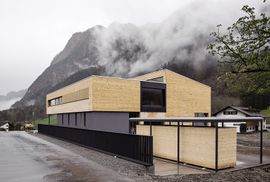Volksschule Brand/en: Unterschied zwischen den Versionen
Aus Smart Places Network
(Die Seite wurde neu angelegt: „Volksschule Brand“) |
(Die Seite wurde neu angelegt: „{{Standort |Standort= Österreich 6708 Brand |Kategorie= Best practice examples }} {{Gallerie Element |Bild=Volksschule Brand.jpg }} {{Best practice examples e…“) |
||
| Zeile 7: | Zeile 7: | ||
|Bild=Volksschule Brand.jpg | |Bild=Volksschule Brand.jpg | ||
}} | }} | ||
| − | {{Best practice | + | {{Best practice examples englisch |
| − | |Bauherr= | + | |Bauherr=Community of brand |
| − | |Baukosten € brutto= | + | |Baukosten € brutto=unknown. |
| − | |Heizungsart= | + | |Heizungsart=unkown. |
| − | |Projektbeschreibung= | + | |Projektbeschreibung=The architects Christian Zottele, Markus Mallin and Bruno Spagolla created a building with a significant connection to its location and function in the Vorarlberg municipality of Brand with 670 inhabitants. Two primary school classes, a kindergarten, a day care centre and a music school were to be accommodated within one building. This task resulted in a special design achievement that deserves top marks. Aware of the historical context of the site, the team of architects set to work on the design. "In the choice of construction, we drew on the Walser tradition. We tried to build a solid wood structure that, on the one hand, makes the structural parts as visible and tangible as possible and, on the other hand, at the same time fulfils all the technical requirements of a school in terms of sound and fire protection," reports architect Zottele. With this wish, the planners encountered a high standard requirement that should not be underestimated, especially in school construction, as Zottele continues: "The complexity of a school is very high and cannot be compared to an average commercial building or a single-family house." |
| − | |Baustoff Holz= | + | (holzbau austria, Kathrin Lanz) |
| + | |Baustoff Holz=fir | ||
|Planungsprozess=zottele . mallin architekturbüro, Bludenz, Mag. Arch. Bruno Spagolla, Bludenz | |Planungsprozess=zottele . mallin architekturbüro, Bludenz, Mag. Arch. Bruno Spagolla, Bludenz | ||
| − | |Bauabwicklung= | + | |Bauabwicklung=Carpentry Müller, Brand |
| − | |Informationen zur Regionalität= | + | |Informationen zur Regionalität="It was clear from the beginning in the community council that it would be a wooden building. The regional wood came from a timber merchant in Walsertal, from whom all the craftsmen had to buy. It was already pointed out in the tender that it had to be regional wood: This applies to the exterior façade and the interior fittings, including the furniture. Here, local silver fir was used. Only the prefabricated building elements come from Styria. |
}} | }} | ||
Aktuelle Version vom 10. Dezember 2020, 14:01 Uhr
| Principal | Community of brand | |
|---|---|---|
| Address | ||
| Energy planning | ||
| year fo finalisation | ||
| Construction costs € brutto | unknown. | |
| Base area[m²] | ||
| Useful area[m²] | ||
| Cubage [m³] | ||
| Heating demand [kWh/(m²BGFa] | ||
| Heatingsystem | unkown. | |
| Technical data other object types | ||
| Project description | The architects Christian Zottele, Markus Mallin and Bruno Spagolla created a building with a significant connection to its location and function in the Vorarlberg municipality of Brand with 670 inhabitants. Two primary school classes, a kindergarten, a day care centre and a music school were to be accommodated within one building. This task resulted in a special design achievement that deserves top marks. Aware of the historical context of the site, the team of architects set to work on the design. "In the choice of construction, we drew on the Walser tradition. We tried to build a solid wood structure that, on the one hand, makes the structural parts as visible and tangible as possible and, on the other hand, at the same time fulfils all the technical requirements of a school in terms of sound and fire protection," reports architect Zottele. With this wish, the planners encountered a high standard requirement that should not be underestimated, especially in school construction, as Zottele continues: "The complexity of a school is very high and cannot be compared to an average commercial building or a single-family house."
(holzbau austria, Kathrin Lanz) | |
| Construction material timber | fir | |
| Planning | zottele . mallin architekturbüro, Bludenz, Mag. Arch. Bruno Spagolla, Bludenz | |
| Construction processing | Carpentry Müller, Brand | |
| Information on regionality | "It was clear from the beginning in the community council that it would be a wooden building. The regional wood came from a timber merchant in Walsertal, from whom all the craftsmen had to buy. It was already pointed out in the tender that it had to be regional wood: This applies to the exterior façade and the interior fittings, including the furniture. Here, local silver fir was used. Only the prefabricated building elements come from Styria. | |
| Further information | ||

